The Intel SSD 910 Review
by Anand Lal Shimpi on August 9, 2012 1:00 PM EST- Posted in
- Storage
- SSDs
- Intel
- Intel SSD 910
The Drive and The Teardown
The 910 starts as a half height PCIe 2.0 x8 card, although a full height bracket comes in the box as well:
Intel sent us the 800GB 910, which features three total PCB layers that are sandwiched together. The 400GB model only has two boards. The top one/two PCBs (400GB/800GB) are home exclusively to NAND packages, the final PCB is where all of the controllers and DRAM reside. Each NAND PCB is home to a total of 28 NAND packages, for a total of 56 NAND devices on an 800GB Intel SSD 910. Here's a shot of the back of the topmost PCB:
Each PCB has 17 NAND packages on the front and 11 on the back. If you look closely (and remember Intel's NAND nomenclature) you'll realize that these are quad-die 25nm MLC-HET NAND packages with a total capacity of 32GB per package. Do the math and that works out to be 1792GB of NAND on a 800GB drive (I originally underestimated how much NAND Intel was putting on these things). Intel uses copious amounts of NAND as spare area in all of its enterprise class SSDs (the 2.5" 200GB Intel SSD 710 used 320GB of NAND). Having tons of spare area helps ensure write amplification remains low and keeps endurance high, allowing the 910 to hit Intel's aggressive 7 - 14 Petabyte endurance target.
| Intel SSD 910 Endurance Ratings | ||||
| 400GB | 800GB | |||
| 4KB Random Write | Up to 5PB | Up to 7PB | ||
| 8KB Random Write | Up to 10PB | Up to 14PB | ||
Remove the topmost PCB on the 800GB drive and you'll see the middle layer with another 28 NAND packages totalling 896GB. The NAND is organized in the same 17 + 11 confguration as the top PCB:
This next shot is the middle PCB again, just removed from the stack completely:
and here's the back of the second PCB:
The final PCB in the stack is home to the four Intel/Hitachi controllers and half of the 2GB of DDR2-800:
Under the heatsink is LSI's 2008 SAS to PCIe bridge, responsible for connecting all of the Intel/Hitachi controllers to the outside world. Finally we have the back of the Intel SSD 910, which is home to the other half of the 2GB of DDR2-800 on the card:
The 910 is a very compact design and is well assembled. The whole thing, even in its half height form factor only occupies a single PCIe slot. Cooling the card isn't a problem for a conventional server, Intel claims you need 200LFM of air to keep the 910 within comfortable temperatures.


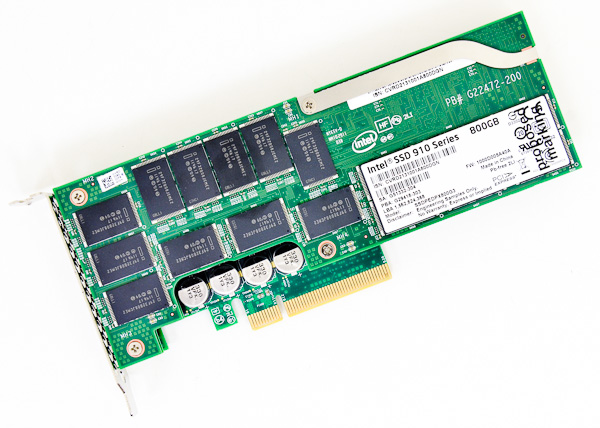

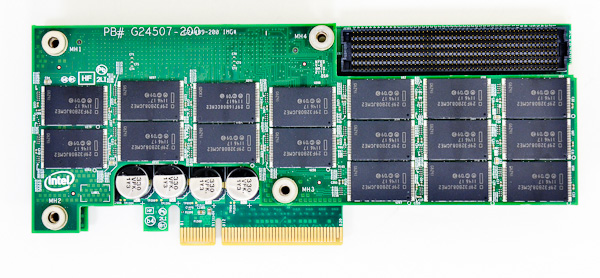
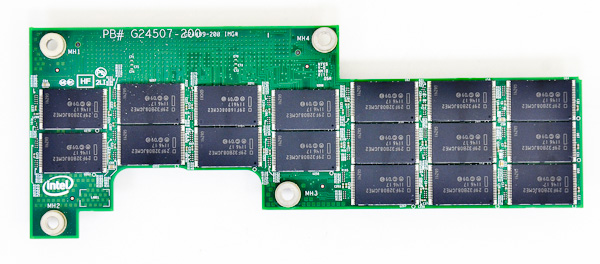
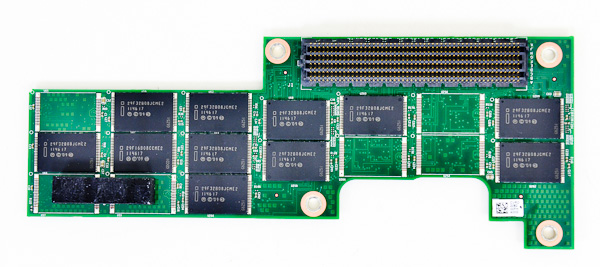
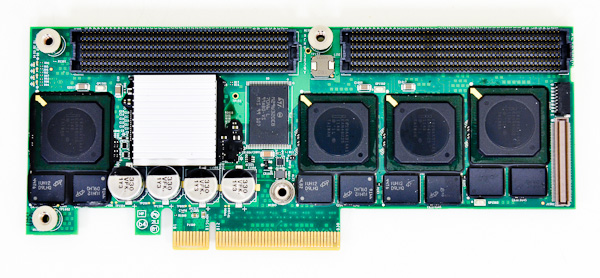
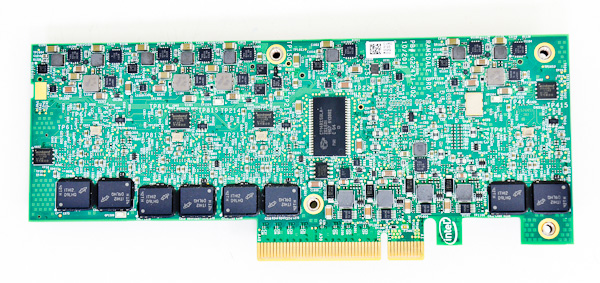








39 Comments
View All Comments
lorribot - Thursday, August 9, 2012 - link
I like the idea but coming from a highly redundant arrays point of view how do you set this all up in a a safe and secure way, what are the points of failure? what happens if you lose the bridge chip, is all your data dead and buried?Would you be looking to put say 3 of these cards in a server and software raid 5 across the cards for multiple disks?
No hardware raid solution will work across multiple PCI-e cards so there really needs to be some work in how to manage all this in a sensible way needs to be done.
I doubt any one in an Enterprise would stick one of these in a server and use it as primary storage for their SAP database it is way too risky a proposition.
What would be good is a 3 1/5 format drive with a fibre channel interface that could work in existing storage solutions.
FunBunny2 - Thursday, August 9, 2012 - link
-- What would be good is a 3 1/5 format drive with a fibre channel interface that could work in existing storage solutions.If memory serves, that's what STEC made and hasn't been all that profitable.
Guspaz - Thursday, August 9, 2012 - link
At the end of the first page, "performnace"happycamperjack - Thursday, August 9, 2012 - link
Wouldn't it be more fair to compare it to a 800 gb CM88 R4 since it's around the same capacity and price as the intel 910 and quite a bit faster.Elixer - Thursday, August 9, 2012 - link
What happens when it is over 60% full on these things ? I am betting a huge drop off in speed, just like the desktop parts.MrSpadge - Sunday, August 12, 2012 - link
Probably not, since they're >50% overprovisioned.Jammrock - Thursday, August 9, 2012 - link
I would like to see some Fusion-IO tests. They are generally considered the highest end in enterprise SSDs. I've played with some in the past and they were crazy fast and reliable.puffpio - Friday, August 10, 2012 - link
agreed..any thoughts on a heads up between this and a similar capacity fusion io iodrive2?happycamperjack - Friday, August 10, 2012 - link
http://hothardware.com/Reviews/Intel-SSD-910-PCI-E...hmmmmmm - Saturday, August 11, 2012 - link
unfortunately, they are comparing the 910 to a 2009, discontinued card from fusion-io. would like to see a new card in the comparison to be able to compare what's on the market today